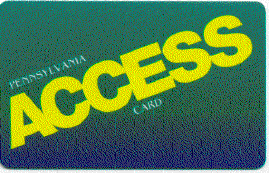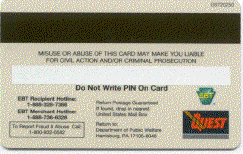
The Pennsylvania EBT ACCESS card is an industry-standard plastic card with a magnetic stripe giving recipients access to cash assistance, SNAP benefits, or Medical Assistance benefits (or any combination of them). Recipients get SNAP benefits electronically through point-of-sale (POS) terminals in authorized food stores. They can get cash assistance through POS terminals and automated teller machines (ATMs). Recipients can verify their eligibility for Medical Assistance through the online Eligibility Verification System (EVS).


The primary account number (PAN) is the 19-digit number printed on the front of the card. The PAN numbers are as follows:
The first six digits are the bank identification number (BIN) identifying the card as Pennsylvania EBT.
The next nine digits are the eCIS recipient number.
The 16th digit is the validation digit for the recipient number.
The 17th and 18th digits equal the card number that shows on CQIPAC screen.
The last digit is the PAN validation number.
The CAO must issue the initial EBT ACCESS card to the household member designated as the payment name. Any client other than authorized representatives (ARs), secondary card members, and expedited SNAP recipients may request to have a card issued centrally.
EBT ACCESS cards should be issued centrally except for Expedited SNAP benefits, Authorized Representative cards, secondary cards, emergency situations, or the card is damaged. The CAO must tell the client that it will take three to seven days to receive a centrally issued EBT ACCESS card. The CAO must use the EBT administrative workstation or a desktop computer to produce recipients’ EBT ACCESS cards. The workstation connects the CAO to the EBT system through the Commonwealth's network. This allows information to be transmitted between the EBT system and CIS and allows the CAO to make inquiries into the EBT system database. (For more information, see the Pennsylvania Electronic Benefit Transfer Xerox AT manual.)
NOTE: EBT cards may be created locally and mailed to the client from the CAO in the following circumstances: Expedited SNAP and emergency situations.
If the recipient is known to CIS, the workstation can produce a card. For new applicants, the CAO must first authorize benefits and CIS must assign a recipient number before an EBT card can be printed. CIS maintains a record of each card the CAO issues. The Xerox database also captures this information.
There are three card-issuance functions:
Issuance of a primary card
Issuance of a card to a secondary cardholder or AR
Issuance of a replacement card
There are three types of EBT cards:
A primary EBT card for the payment name
Issuance of this card establishes the account on the EBT system. The CAO must always issue this card first.
A secondary card for another adult in the household
The secondary cardholder must be an authorized and active member of the budget and be 18 years or older. This includes EE members The CAO must explain to the primary cardholder that the secondary cardholder has the same access to benefits as the primary cardholder. The CAO must get the primary cardholder’s approval before issuing the secondary card. The CAO must explain that the primary cardholder is responsible for the issued benefits if there is an overpayment.
An AR card
This allows a recipient who is unable to use the EBT system because of a disability to designate someone to access benefits. The recipient may authorize access to cash assistance or SNAP benefits or both. (See Chapter 505.)
The CAO may issue no more than two EBT ACCESS cards per household—a primary card and, if it is requested, either a secondary card or an AR card.
After the CAO prints an EBT ACCESS card for the recipient, the recipient must choose a personal identification number (PIN) using the Xerox PIN select. The PIN is a four-digit code that the cardholder must use to begin a transaction at either a POS or ATM. The PIN is the main means of security for the recipient’s EBT account.
The PIN selection must be confidential. The CAO must provide an area where the recipient can select a PIN without being observed by others.
The CAO must tell the recipient not to reveal the PIN to anyone because doing so would jeopardize the benefits in the account. The CAO must also remind recipients that they have three chances to enter the correct pin when using their EBT card for a purchase. After three wrong tries, the EBT system locks the card and prevents any transactions until the next day unless the recipient selects a new PIN at the CAO or by telephone.
If recipients forget their PINs, they may call the Xerox customer service line at 1-888-328-7366 to select new PINs.
DHS issues replacements for lost or stolen cards centrally. A $2.50 card-replacement fee is taken from the client’s account.
The CAO may issue a card locally if the client has an emergency justifying immediate replacement of a lost or stolen card. The executive director or his or her designate must approve the request.
The CAO must replace a client's damaged EBT ACCESS card upon request, without charging a fee.
The CAO must maintain the Daily EBT Card Log for a replacement that is not issued centrally (see Chapter 580, Appendix D).
NOTE: Even though a case may be closed, the recipient needs the replacement card to access benefits still in the account.
The CAO must complete an EBT Card Request form and get the recipient’s signature on the form. The form must be kept in the case record. (See the sample in Chapter 580, Appendix A.)
The CAO must monitor card replacements when the recipient requests multiple replacements for lost or stolen cards. After three replacements of a lost or stolen card within six months or two or more replacements in one month, the CAO must schedule the recipient for an interview with an OIM supervisor to discuss the recipient’s responsibility to keep the card safe. The OIM supervisor must tell the recipient that illegal use of the card may result in disqualification and that further replacements will result in a referral to the Office of Inspector General (OIG).
The CAO must not deny or delay a recipient's request for replacement of the EBT ACCESS card.
The CAO must make a referral to the OIG when:
The CAO suspects misuse;
The recipient asks for and gets more than one replacement of lost, stolen, or damaged cards in one month; or
The recipient asks for and gets more than four replacements of lost, stolen, or damaged cards in six months.
The CAO must send card-replacement forms to the OIG at the address at the bottom of the form. A separate memorandum is not necessary.
NOTE: Only CAOs and district offices can replace the Pennsylvania EBT ACCESS cards.
The CAO must apply a card-replacement fee as follows:
There is no cost to replace the EBT ACCESS card for recipients who reapply for cash assistance or SNAP benefits after a break in eligibility.
There is no cost to replace a damaged or defective card the recipient returns to the CAO.
There is no cost to replace cards issued to ARs.
The CAO must allow one replacement per payment name at no cost for cards lost or stolen during the period that the EBT account remains active.
The CAO must charge a $2.50 replacement fee for all other lost or stolen cards that are replaced.
NOTE: The EBT system automatically deducts the card-replacement fee from the recipient’s EBT cash assistance or SNAP account. If the recipient has both a cash assistance and a SNAP account balance, the system deducts the $2.50 fee from the cash account. If the cash assistance balance is zero or the recipient has a SNAP-only account, the system deducts the fee from the SNAP account.
NOTE: The CAO must never collect cash directly from the recipient for the EBT card-replacement fee. It must collect the fee through the EBT account.
The CAO must use the override option to waive the fee in the situations described above where there is no fee. The CAO must also waive the fee in exceptional circumstances or in cases with insufficient funds in the account if the recipient needs the replacement card to access medical services.
NOTE: If the card-replacement fee is charged in error, the CAO must reimburse the recipient using supplemental benefit reason code 183.
Benefits are available and accessible by recipients on the EBT system when the following conditions are met:
There is an active EBT card;
The recipient enters a PIN on the Xerox PIN device; and
The authorized benefits are posted to the EBT account.
Several situations can happen when the CAO creates EBT accounts and issues EBT ACCESS cards. Each situation has a different effect on the availability of EBT benefits. Here are the situations and effects:
The CAO authorizes the benefit, issues the EBT card, and the recipient selects a PIN, all on the same day. For applicants, the benefit is available at 6:00 a.m. the next calendar day.
The CAO authorizes the benefit on the first day, but the recipient does not get the card and PIN until the second day. The benefit is available after midnight on the second day.
The CAO authorizes the benefit and issues the EBT card on the first day, but the recipient does not choose a PIN on that day. An inquiry on the EBT system shows the card status as 00. This means the card has no PIN. (See the EBT administrative manual for other code meanings.) The recipient may come into the CAO or call the Xerox service line any time after that first day to select a PIN. The benefit is available within an hour after the recipient selects a PIN.
The CAO replaces an EBT card with benefits already in the account. The benefits are available as soon as the recipient chooses a PIN for the new card. If a card is replaced for an active account with a zero balance, benefits are available after 6:00 a.m. on the benefit-issuance date for that recipient.
The recipient chooses a new PIN for an existing card. The benefits are available immediately, and the block that was caused by three incorrect PIN entries is removed.
Reissued October 5, 2015, replacing October 2, 2015